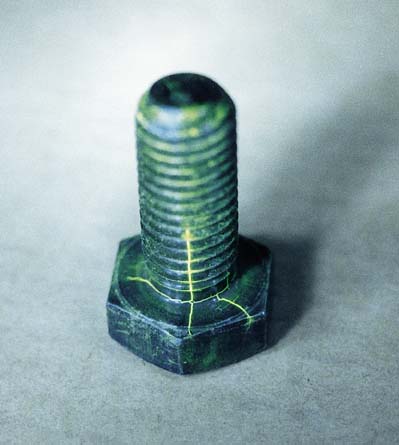Basic Test Theory
Liquid penetration testing is used to reveal surface discontinuities by bleedout of a colored or fluorescent dye in the penetrant from within the flaw. This test method is based on the ability of a liquid to be drawn into a "clean" surface breaking flaw by capillary action. After a period of time called the "dwell", excess surface penetrant is removed and a developer applied. The developer acts as a "blotter" and draws the penetrant out from the discontinuity to reveal it's presence.
Penetrants can be categorized by the type of dye they employee those being either visible or fluorescent. Visible or colored contrast penetrant are usually red in color and requires good white light while fluorescent penetrants need to be used in darkened conditions with an ultraviolet "black light".
Penetrant can futher be classified by the method required for removal. These methods of removal are:
1. Water Washable (Removed with a water spray)
2. Post Emulsifiable (Oil based - Requires an emulsfier before it can be removed with water)
3. Solvent Removable (Requires a solvent for removal)
Penetrant inspection can be performed on any solid and essentially nonporous material. If surface penetrant is not fully removed, misleading indications will result.
Applications
Surface cracks not readily visible to the unaided eye.
Excellent for finding surface flaws in castings, weldments, wrought stock, etc.
Typical flaws located with this test method include - cracks, porosity,blow holes, shrinkage, non-metallic inclusions, incomplete root penetration,undercutting, icicles, and burn through, etc.
Benefits of the Process
Low-cost method.
Excellent for detecting surface discontinuities -especially surface cracks.
Permits controlled sensitivity.
Applicable to magnetic and nonmagnetic materials.
In thin-walled vessels, will reveal leaks not ordinarily located by usual air tests.
Easy to use.
May be applied to a wide variety of test materials
Has a high sensitivity to very fine or tight surface discontinuities
Indications appear on the actual test part
Readily adapted to high volume production line inspection
PT is a normally fast method of inspection which can be relatively inexpensive to use
Disadvantages/Limitations of the Process
It is essential that the specimen being tested be carefully cleaned first, otherwise the penetrant will not be able to get into a discontinuity.
Surface irregularities can give misleading indications.
Parts must be free from contaminants and coatings which could block penetrant travel
Some penetrant materials may adversely affect plastic and rubber components
Equipment Needed
Commercial kits,containing fluorescent or visible dye and developers.
Work Stations for maunfacturing production applications.
Application equipment for the developer.
A source of ultraviolet light - if the fluorescent dye method isused.
Workmanship standards
Online Reference Links (additional links in member area)
Magnaflux - MSDS Sheets
Ardrox - MSDS Sheets
|

